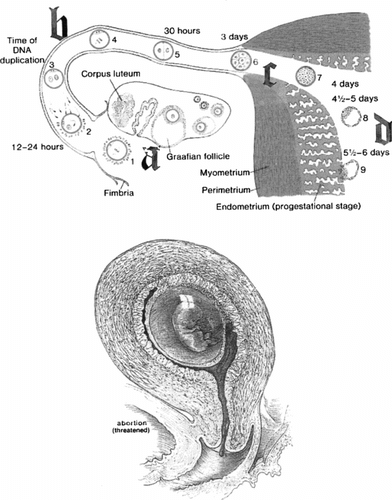INITIATION OF THE REPRODUCTIVE CYCLE
The reproductive cycle initiated by the sperm involves a highly coordinated and complex biochemical reaction involving sperm motility, sperm transport in the reproductive tract, fertilization, nuclear interaction, morula formation, blastocyst expansion, release of zona pellucida, implantation and eudiometrical compatability for survival of the early embryo.
RELIGION/ABORTION
In the USA (mostly Christian population), as of 2006, abortion is legal. The Supreme Court made this decision when the Roe vs. Wade case came before them some 35 years ago. Court is now attempting to overturn this decision. The Bible states “Thou shalt not kill”; this would include innocent embryos. In Egypt (mostly Muslem population), abortion is illegal. However, certain physicians may perform illegal abortions for certain fees even at the expense of the mother's health. A “fatwa” is occasionally made for certain circumstances for abortion.
A comparable controversy is learning about the role of homosexual priests in the Roman Catholic Church. The Vatican document, the first major policy statement of Pope Benedict XVI's papacy, was officially released. The Vatican defended a policy statement designed to keep men with “deep-seated” homosexual tendencies from becoming priests, but said there would be no crackdown on gays who are already ordained.
Verse 32 from Holy Quran—Creation: God created a tiny cell into fertilized egg morula, blast cyst in uterus, delivered into a child who grows until puberty and beyond. Some of you will die and some live on the land with water for plants to flourish (see ).
US Supreme Court/Abortion
The US Supreme Court wrestled with a New Hampshire law that requires a parent to be told before a daughter ends her pregnancy, with no hint justices were ready for a dramatic retreat on abortion rights under their new Chief.
The court is dealing with its first abortion case in five years. Chief Justice John Roberts was seeking a compromise solution to the parental notification statute. The state of New Hampshire appealed to the Supreme Court, arguing that the court's past abortion rights decisions do not require a health exception to the parental notification. A broad decision in the state's favor could clear the way for other states to enact similar statutes. The federal ban on the late-term procedure called “partial birth” abortion by opponents. The administration backs New Hampshire in the case. Several justices said the law was flawed because it requires that a parent be informed 48 hours before a minor child has an abortion, but makes no exception for a medical emergency that threatens the youth's health. Samuel Alito wrote a memo 20 years ago on bringing about the eventual overturning of Roe v. Wade. Physician gynecologists would fear being prosecuted or sued if they performed an abortion on a severely sick minor who did not want to notify a parent.
CONTROVERSIES/RELIGIOUS PARAMETERS
The current controversies regarding contraception, natural family planning (NFP), spontaneous/induced abortion are very similar in the three major regions of Islam, Christianity, and Judiasm. The pro-life movement has long opposed the morning-after pill as abortion in disguise, not the “emergency contraception” it is supposed to be. Anti-abortion groups argue that by preventing implantation of a fertilized egg, it destroys a fetus. This has begun enough to deter the Food and Drug Administration from approving an application to allow over-the-counter sales of the medication known as Plan B. Recent advances in reproductive physiology indicate that the morning-after pill serves to block fertilization, while having no effect on implantation. That makes it “contraception, not abortion.”
On the other hand, the “pro-life” group are anti-abortion and are against the morning-after pill when its function is still vague. Scientists report that this is a grave mistake to keep opposing it. In fact, there was a drug once believed to induce abortion and was found to prevent abortion. For some 2 years, the FDA has been reluctant to make a decision on the application, ignoring the advice of its own scientists who recommend that the drug should be available without prescription.
Recently, the Government Accountability Office (GAO), an investigative arm of Congress, released a report that gave a withering critique of the agency's handling of the issue. It would appear that high level officials at FDA decided against Plan B before the scientific review had been done, as part of an approach, the GAO described with such adjectives as “unusual,” “novel” and “unprecedented”—a polite, bureaucratic style of saying “outrageous.”
Several organizations are against abortion and do not recommend Plan B at all. The American Life League reports that Plan B aborts children and hurts women's health. Other family planning organizations oppose it partly because of its “abortifacient potential.” Extensive reviews have been compiled on the morning-after pill, indicating that they are against abortion and do recommend Plan B. Meanwhile, there is a surprising consensus among experts that “there is no scientific evidence the pills prevent implantation—and considerable evidence that the mode of action is mainly by blocking the release of an egg from the ovary so no embryo is developed.” The Karolinska Institute in Stockholm reports that the pill's effects “involve either blockade or delay of ovulation…rather than inhibition of implantation.”
It is concluded that the drug can prevent pregnancy by impeding sperm and by delaying ovulation, but it has “not been shown to cause a post-fertilization event—a change in the uterus that could interfere with implantation of a fertilized egg.” There is no published research to indicate that emergency contraception never interferes with implantation. Thus, the mere possibility of an adverse event is a weak reason to reject its use. If emergency contraception was widely and easily available, it could prevent a lot of pregnancies that would otherwise end tragically in abortion. Thus, the FDA had approved over-the-counter sales. It is hoped that research scientists of major scientific organizations, pharmaceutical companies and theologians would meet in a combined conference to clarify with specific directives for couples in their reproductive years. The meeting should include high level officials of the National Institute of Health (NIH), Government Accountability Office (GAO), Food and Drug Administration (FDA) and Office of Women's Health.
PHYSIOLOGY OF MORNING-AFTER PILL
Emergency contraception involves the “morning-after pill.” It is emphasized that the mode of action of this drug varies according to the stage of the menstrual cycle at which the drug is taken. If the drug is taken during the follicular phase of the menstrual cycle it acts primarily on the ovary and may either : a) interfere with the release of the egg from the ovary, or b) it destroys the recently fertilized egg (). If, however, the morning-after pill is given during the luteal phase of the menstrual cycle, it destroys the morula, early blastocyst stage, preventing implantation.
FIGURE 2 A diagrammatic representation of the in vivo environment where fertilization and embryo development take place. Mode of action of morning-after pill when given at different stages of the menstrual cycle. When the drug is given during the follicular phase of the cycle either blocks (a) ovulation, or interferes with (b) fertilization. If, however, the drug is administered during the luteal phase of the menstrual cycle, it may destroy (c) the morula, or (d) the early stages of the blastocyst prior to implantation.

UNANSWERED QUESTIONS
What is the dividing line between what is happening in normal women vs. the effects of oral contraceptives/morning-after pill?
What is the mode of action of morning-after pills? Do they prevent implantation or cause resorption of fully expanding blastocyst?
What is the precise definition of “abortion”? Does “abortion” include induced death of pre-implantation blastocyst of resorption of newly implanted blastcysts as a result of dramatic changes in functional ultrastructure of the eudiometrical lining at the site of implantation?
What is the difference between a natural miscarriage and a drug induced miscarriage?
